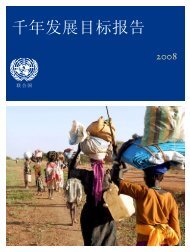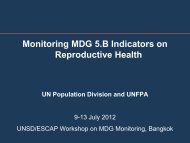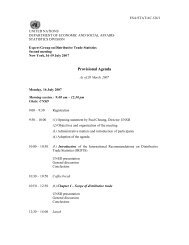demographic yearbook annuaire demographique 1951
demographic yearbook annuaire demographique 1951
demographic yearbook annuaire demographique 1951
You also want an ePaper? Increase the reach of your titles
YUMPU automatically turns print PDFs into web optimized ePapers that Google loves.
certain to indicate improvement in coverage rather than a<br />
rise in fertility or mortality. Rising stillbirth ratios are also<br />
likely to indicate improved registration. Furthermore, temporary<br />
measures, such as the removal of registration fees in<br />
order to encourage registration, may cause the numbers to<br />
rise sharply in certain years. Where tabulations include delayed<br />
registration, the fluctuations are particularly violent.<br />
When factors of this type are known to be operating, they<br />
are noted in the tables.<br />
Another source of variation in the statistics of births and<br />
deaths lies in the definition of births, deaths and stillbirths.<br />
Almost universally births and deaths are so defined as to<br />
exclude stillbirths. But variation in the definition of stillbirths<br />
results in some variation in the definition of live births<br />
and deaths. From the viewpoint of the accuracy and comparability<br />
of stillbirth statistics, it is necessary to establish a<br />
uniform and definite criterion differentiating between stillbirths<br />
and other products of human gestation which have<br />
not yet reached the stage of development justifying their<br />
inclusion as stillbirths. However, from the viewpoint of<br />
accuracy and comparability of live birth and death statistics<br />
it is more important to establish a uniform and definite<br />
criterion differentiating between stillbirths and live births.<br />
Variations in registration procedure may have an important<br />
eflect in this regard. The legal time allowed for registration<br />
of a live birth varies from twenty-four hours to one year or<br />
more. Infants who die shortly after birth are therefore sometimes<br />
omitted from the birth registrations, and because the<br />
deaths were almost immediate, they also fail to be recorded<br />
as deaths.<br />
In several countries, the definition of a stillbirth for<br />
statistical purposes is broadened to include those infants,<br />
born alive, who die before registration of birth. These births<br />
of infants dying before registration are therefore excluded<br />
from the live birth statistics and their deaths from the death<br />
statistics. As a result, stillbirth ratios are exaggerated and<br />
general birth and death rates are understated to some degree.<br />
The infant mortality rate is also affected, for, although<br />
both the components of the rate are deficient by the same<br />
absolute amount, the rate nevertheless tends to understate'<br />
actual mortality because the deficiency is proportionately<br />
greater in relation to the number of infant deaths than in<br />
relation to the number of births.<br />
Problems of comparability stemming from these sources<br />
will be lessened as international standards of definition and<br />
classification are developed. Some progress has already been<br />
made in the work of the Expert Committee on Health Statistics<br />
of the World Health Organization which has recommended<br />
uniform procedures for adoption by the various<br />
countries.<br />
As the information given in the code columns and in the<br />
footnotes makes clear, some of the material presented in the<br />
tables is useful, not as a measure of actual levels and changes,<br />
but rather as an indication of where registration systems are<br />
in effect and as a record of progress toward a more complete<br />
registration of vital events. The coverage for Africa is par<br />
31<br />
ticularly spotty, being largely confined to data on the<br />
"European" population with, as a rule, only a few partial<br />
statistics for the indigenous segments. Similarly, the coverage<br />
is uneven and the statistics incomplete for much of Asia<br />
and for parts of Latin America.<br />
For the computation of the annual rates shown in various<br />
tables, the midyear population was taken as a base whenever<br />
available. Otherwise, averages of year-end estimates or<br />
figures for other dates within the year were taken. The reIatively<br />
few cases in which the rate is based on other than the<br />
midyear population are not noted in the tables since the<br />
effect on the rate is regarded as negligible. In so far as<br />
possible, the vital data relate to the de facto population and<br />
rates are based on the de facto population. The population<br />
base does not in all cases agree precisely with the vital<br />
statistics as to the inclusion or exclusion of certain groups<br />
(armed forces, prisoners ofwar, residents abroad etc.). These<br />
minor variations probably have little effect on the rates,<br />
except for certain areas during the war. Rates are not shown<br />
where the numbers involved are so small that the rates are<br />
subject to severe chance fluctuations or where known differences<br />
between the coverage of vital data and the coverage of<br />
population data are believed sufficient to invalidate the<br />
rates. Except for the data in table 5 and table 12, all rates<br />
were computed in the Statistical Office ofthe United Nations<br />
from official statistics.<br />
BIRTH STATISTICS<br />
Natality statistics are presented in tables 5 to 9. Unless<br />
otherwise noted, stillbirths are excluded, illegitimate births<br />
are included and each member of a multiple birth is counted<br />
separately.<br />
Table 5 presents a summary of crude birth rates for 64<br />
areas during the period 1905 to 1930. These data are average<br />
rates for the periods 1905-1909,1911-1913,1921-1925<br />
and 1926-1930. They were taken from the League of Nations<br />
Yearbook, the data for the first period from the 1928 issue<br />
and the remainder from the 1942-1944 issue. Unless otherwise<br />
noted, the rates refer to the territory of 1937 rather than<br />
to the present territory. In spite of the limitations to comparability<br />
that arise from boundary changes subsequent to<br />
1937 and from the fact that the basic data have not been<br />
systematically revised and the rates recomputed in the light<br />
of more recent information, it is believed that these statistics<br />
are sufficiently reliable and comparable to furnish some<br />
indication of fertility levels and trends from the early years<br />
of the twentieth century up to the period covered by the<br />
more detailed tables. It is not likely that much additional<br />
information has become available since 1905-1930 statistics<br />
were last compiled by the League of Nations.<br />
Table 6 gives the number of births reported, by calendar<br />
years, for the period 1935 to 1950 for 144 areas, and table 7<br />
gives the corresponding annual crude rates (along with rates<br />
for 1930-1934) for 129 areas. The geographic coverage of<br />
the latter table is somewhat less than that of the former because,<br />
in a considerable number of cases, appropriate population<br />
estimates for the computation of rates were not available.<br />
The crude rate is the number of births per 1,000 persons<br />
in the midyear population or, in a minor number of<br />
cases, the population at some other date during the year.<br />
In general, the population totals on which the rates are<br />
based are those presented in table 3. Some exceptions occur<br />
when rates are shown for only a part of the population or<br />
when the years for which data can be presented are only<br />
those years already covered in table 1.<br />
Crude birth rates are a measure of gross additions to the<br />
population through natality, but, because of differences<br />
between countries in the age and sex composition of the<br />
population, these rates do not reflect differences in the frequency<br />
of births among men and women of child-bearing<br />
age very precisely. They give only a general idea of trends<br />
over time and of differences between countries in levels of<br />
fertility.













